Eco-Friendly Pest Management Guide
Jump to a section:
- Integrated Pest Management
- Eco-Friendly Landscape Practices
- Pesticides
- Labels
- “Green, Yellow and Red” Pesticides
- Resources
Introduction
 As a homeowner, you may look to pesticides to prevent or treat both real and perceived problems. Products found at the store may achieve what you want, but are they actually needed? Are they appropriate for use in a residential setting? Are these products the right choice for you and your family?
As a homeowner, you may look to pesticides to prevent or treat both real and perceived problems. Products found at the store may achieve what you want, but are they actually needed? Are they appropriate for use in a residential setting? Are these products the right choice for you and your family?
This two-part resource is intended to provide information about practices and products to address common pest problems for the average homeowner. The first part is a pocket guide with quick reference guidelines for common issues. The second part is the more in depth online content you see here, where you will find additional details about practices and products if you wish to dig deeper.
Download the Pocket Guide (PDF)
How to Use These Resources
In the pocket guide, first review the WHAT IS INTEGRATED PEST MANAGEMENT? panel to set your landscape up for success while minimizing pesticide use. Next, identify your specific pest problem or issue. You will need this diagnosis to decide if any intervention is actually needed and to determine what preventative or curative practices are appropriate.
Review the PESTICIDES and LABELS panels before searching for or choosing particular products. If specific action is necessary, check the GREEN, YELLOW and RED panels for information about practices and products for both insects and weeds. Then if you have more questions about any of these topics, find the corresponding section on this webpage to learn more.
Practices and products are organized into three categories for easy interpretation:
- GREEN — “GO” — Eco-friendly landscape practices and products that are considered low risk for humans and the environment. Prioritize these practices.
- YELLOW — “SLOW” — Products that should be used sparingly and after thoughtful consideration.
- RED — “STOP” — Products to avoid.
What Is Integrated Pest Management?
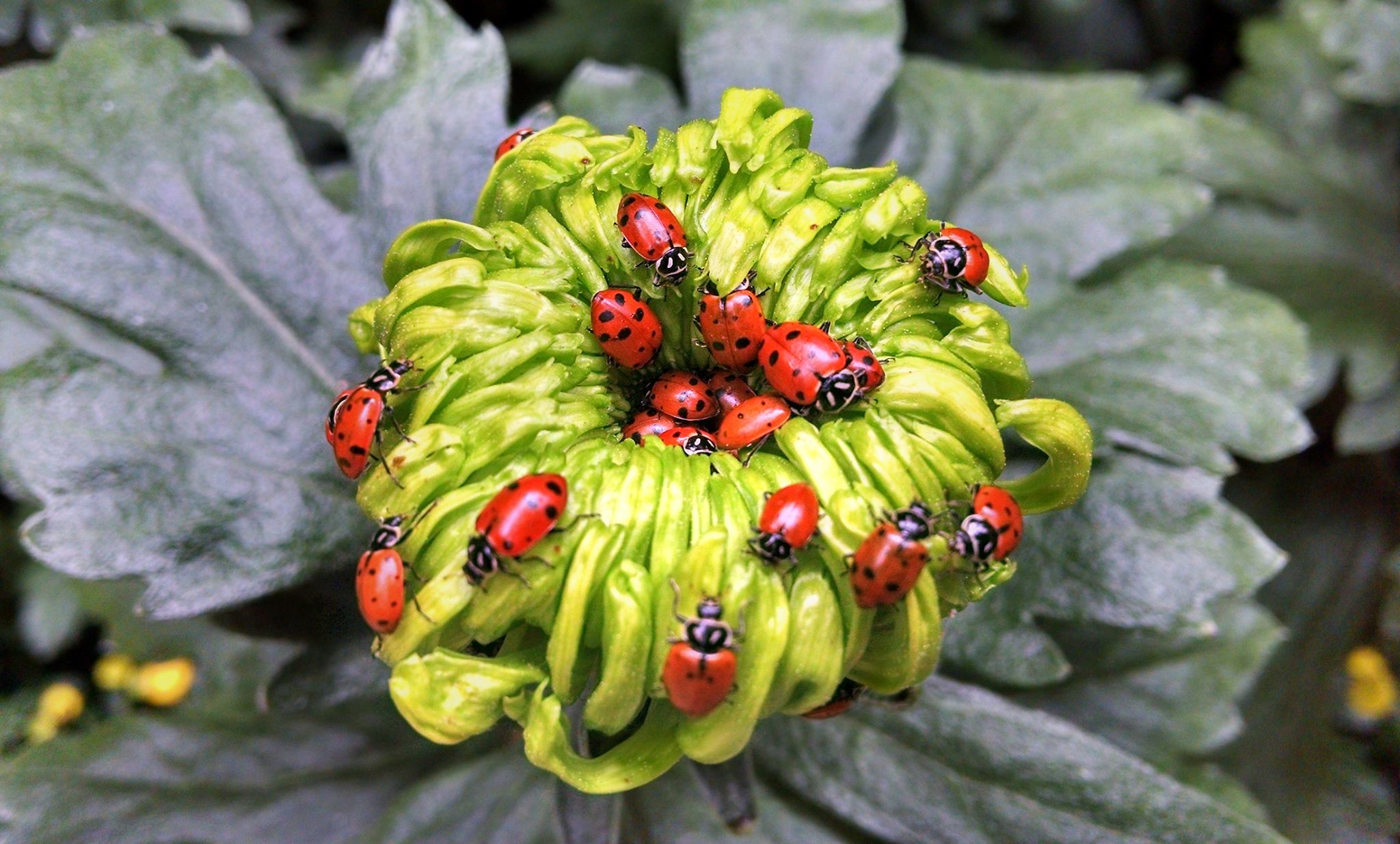
- Integrated pest management (IPM) is an ecosystem-based pest control tactic in which all compatible methods of pest control are used. This includes controlling pests physically, culturally, biologically and chemically.
- IPM emphasizes preventing pest problems. Excluding pests, manually removing pests and having healthy plants will prevent the need for a lot of other more intensive controls.
- IPM does not always have complete pest eradication as its goal. Learn to accept a few insects and a little plant damage in your landscape. This shows that you’re supporting a healthy ecosystem that likely also contains many beneficial organisms!
- Only about 0.1% to 1% of all known insects are potential serious pests. Many other species in your landscape ecosystem benefit you by eating pests or pollinating plants. Promoting and protecting these good bugs is part of many IPM programs.
- Pesticides are not the only means of control. In IPM pesticides are usually only used when the number of pests present reaches a level beyond which the harm to a plant becomes unacceptable. Then a pesticide is chosen that will affect only the targeted pest.
Eco-Friendly Landscape Practices
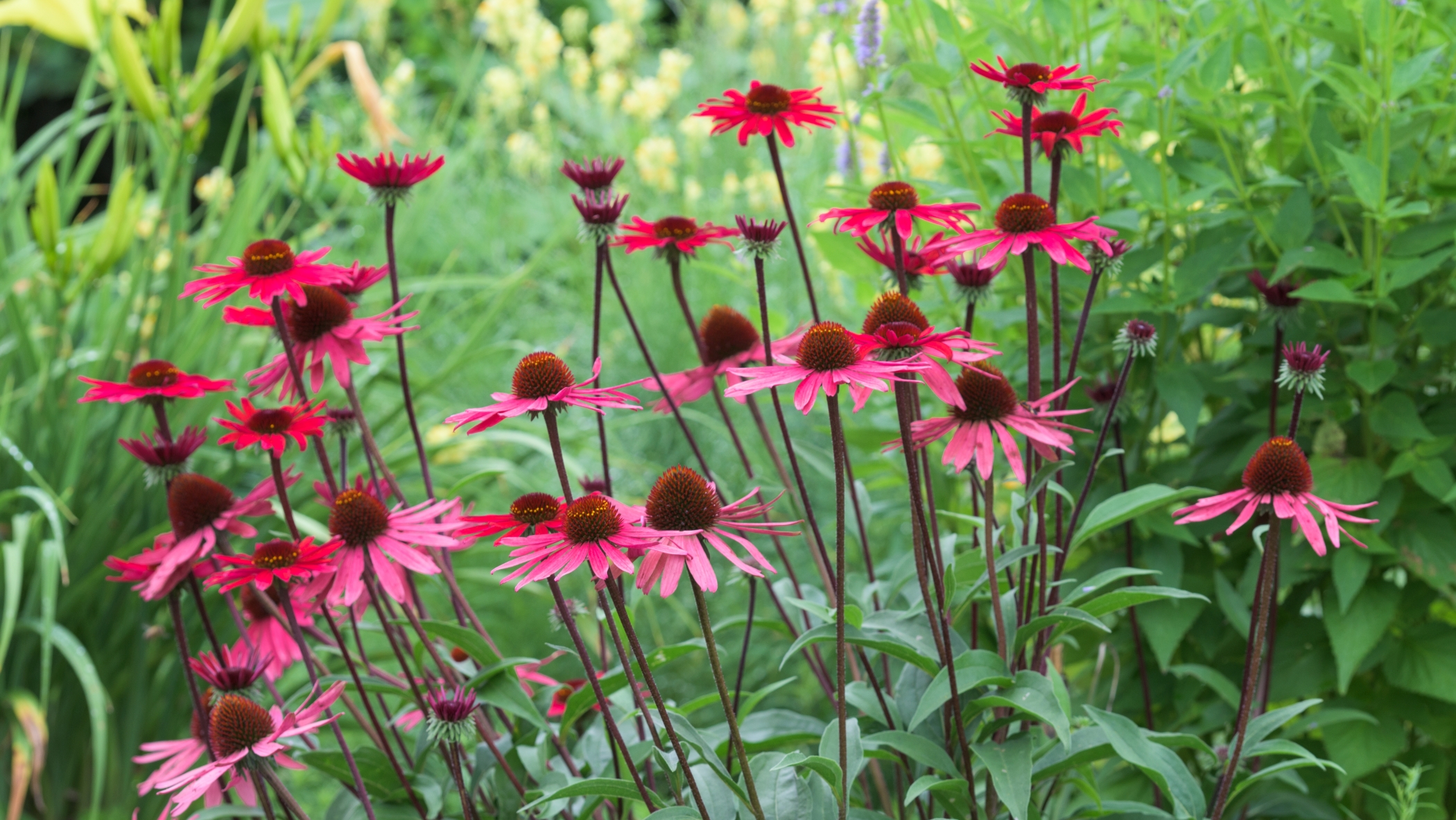
Gardens are complex ecosystems where soil microbes, insects, plants and other elements work together to promote a natural balance. Pest control and fertilizer needs should be minimal in a naturally balanced garden supported by good gardening practices.
Top Ten Tips for a Greener Yard
PLANTING
- Proper plant placement is the most important factor for long-term plant health. Make sure to match plant needs with the proper sun exposure, moisture level and soil type. This concept is called “Right plant, right place.”
- Native and sustainable plants suited to the region’s climate reduce the need for irrigation, fertilizer and disease and pest maintenance. Seek out pest and disease-resistant cultivars for susceptible plants. View our Top 10 Sustainable Plants lists for a selection of Phipps-recommended sustainable plants.
- Avoid invasive plants. They can take over your garden and damage natural areas and waterways. Many nurseries still sell invasive plants, so buyer beware. Find a list of invasive plants found in Pennsylvania at the Department of Conservation and Natural Resources.
WEED MANAGEMENT
- For long lasting weed suppression in your garden beds and paths, apply a layer of newspaper, 4 – 6 sheets thick, or cardboard under a top-dressing of mulch. Avoid glossy or colored pages. Make sure your mulch comes from a reputable source as it can bring new weeds into your yard.
- Remove weeds before they go to seed, and make sure you have a tool which will help you get the whole root. When removing weeds, be careful not to disturb the soil more than necessary as it can bring more weed seeds to the surface. If you disturb an area of soil, it’s a good idea to cover it with an organic mulch.
LAWN CARE
- Thick, healthy grass crowds out weeds. Mow your grass to 3 – 4", add a thin layer of compost each fall, soil test every three years to adjust pH and immediately reseed bare spots.
- Consider plug-in electric or battery powered mower and yard equipment. They are lighter, quieter and easier to maintain, and they don’t create emissions.
PESTS IN THE GARDEN
- Plant nectar and pollen producing plants to attract good bugs to your garden. The Xerxes Society provides a helpful list, and the book Attracting Beneficial Bugs to Your Garden by Jessica Walliser is also an excellent resource.
- Many pests can simply be removed by hand or a sharp stream of water. This is an easy and organic first step that will often solve your pest issue.
FALL MAINTENANCE
- Instead of bagging your leaves in the fall, shred or mow them and apply a layer to garden beds. Leaves are a valuable soil amendment and a free mulch.
For a full list of organic gardening tips, see the NOFA Organic Land Care Program's Introduction to Organic Lawns and Yards.
Pesticides
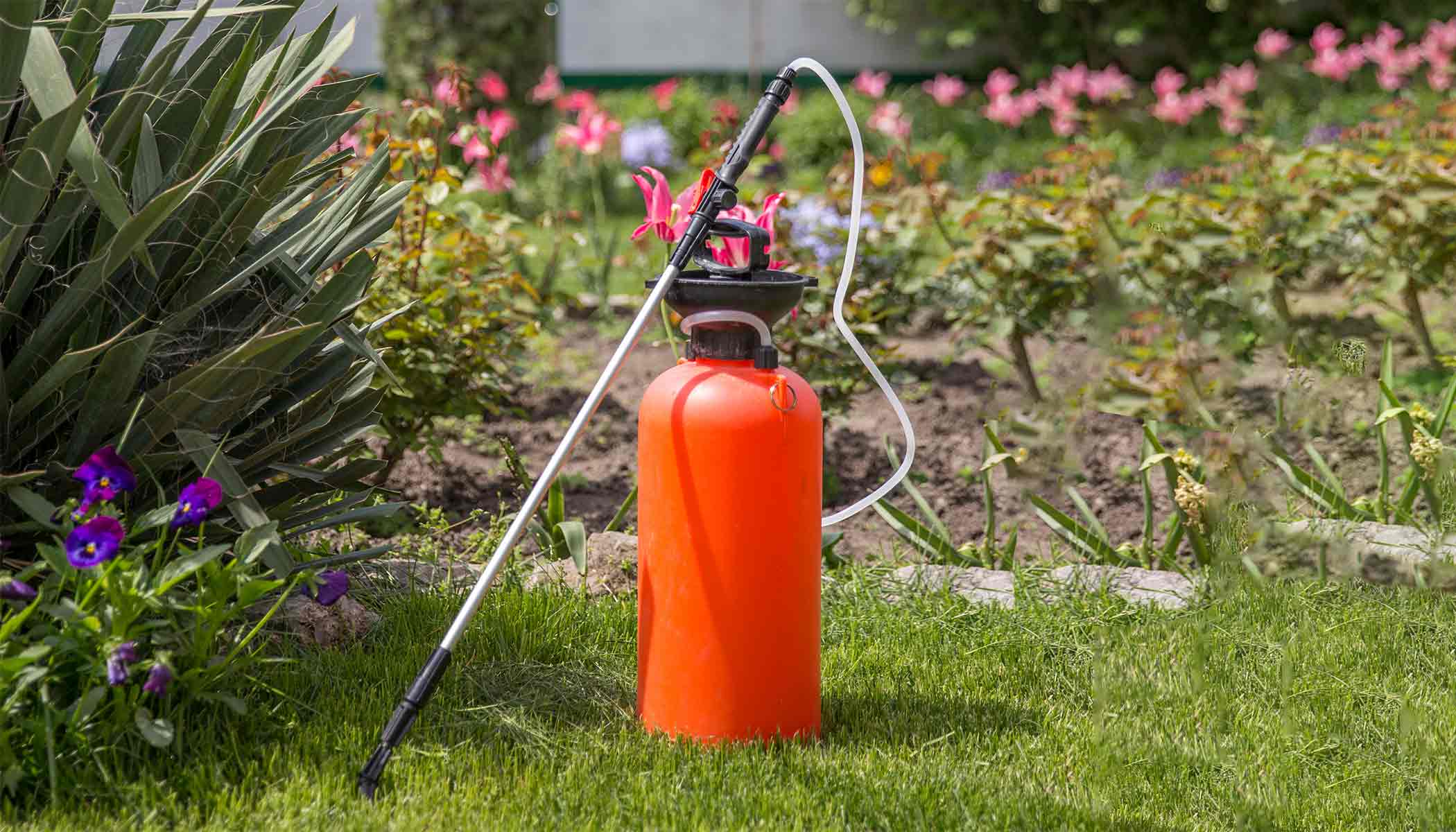
- A pesticide is any substance intended to kill a pest organism. There are pesticides for insects (insecticides), plants (herbicides), fungi (fungicides), rodents (rodenticides), molluscs (molluscicides), algae (algicides), bacteria (bactericides), birds (avicides), fish (piscicides) and other organisms.
- Each pesticide has a particular spectrum of efficacy, or the subset of organisms on which it is intended to work. For example horticultural oil works well on small, soft-bodied aphids but will not do anything to large, mobile, hardened adult beetles. Some pesticides are very broad-spectrum, meaning they will impact many different organisms. Be sure you properly identify your pest first so you choose the correct pesticide.
- Pesticides can also potentially impact organisms other than their intended target, including people. These are called non-target or off-target effects. This is why limiting the use of pesticides and always using them carefully and properly is so important.
- In the home landscape, there is usually little reason for a homeowner to use pesticides. Invasive species of insects or weed, an outbreak of a very damaging species, or pests that affect human health are examples of some situations where a pesticide may be considered for application by a pest control professional.
- Pesticides are regulated under the Federal Insecticide, Fungicide and Rodenticide Act (FIFRA). The label on a pesticide is law and must be followed.
- Never use any pesticide without knowing a pest is actually present. Preventative spraying can do more harm than good in some cases. You may disproportionately affect beneficial organisms and cause a surge of actual pests. In the case of preventative sprays for a known damaging or invasive pest, consult a licensed pest control professional.
Pesticide Labels
- The label on a pesticide package is reviewed and approved by the U.S. EPA. Following the directions on these labels is extremely important because they are actually federal law!
- There is a lot of information on pesticide labels. This section will provide a short breakdown of some of the things you will find on a label. The example generic labels here will show you approximately what to look for on a label and where, though placement of certain items may vary. It’s important to read both the front and back labels of any product before you buy it and before you use it.
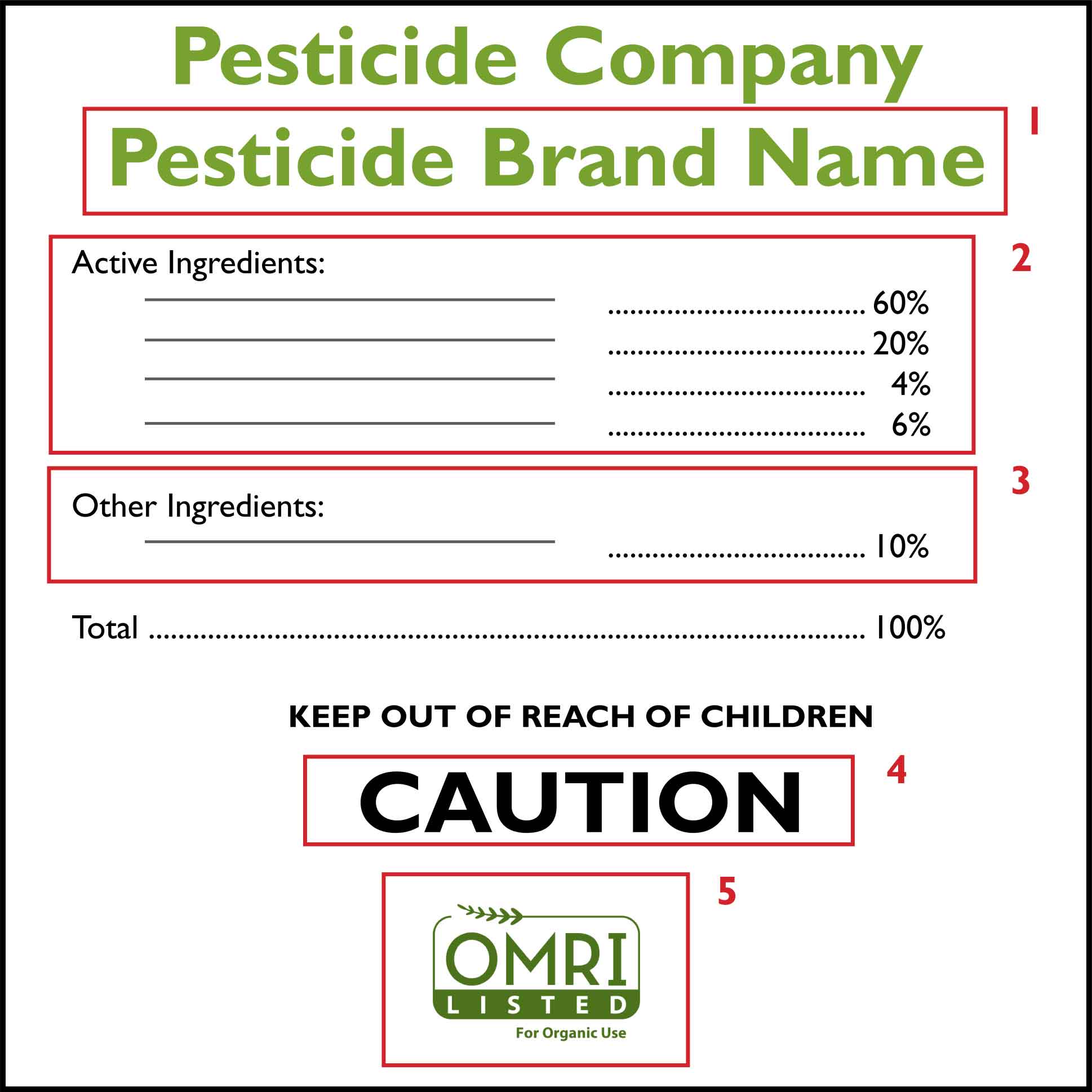
THE FRONT LABEL
- Usually the biggest words on the front label are the brand name (1) of the product.
- The list of active ingredients (2) is generally in smaller print and is usually on the front label. This statement contains the names of the active ingredients (the chemicals that actually affect the pest), the amount of the active ingredient in the product and the amount of inert ingredients in the product. If you do not see this list on the front, check the back label.
- Inert ingredients (3) usually listed as “other ingredients,” do not have pesticidal activity and do not have to be listed. It’s a bonus if they are, though, so you know everything you are applying.
- A signal word (4) written in all capital letters on the front label tells you about the relative toxicity of the product to you. From least toxic to most toxic, these signal words are CAUTION, WARNING and DANGER.
- An additional logo or language indicating an organic pesticide (5) simply means the product is approved for use in organic plant production. It is not necessarily an indication of lower toxicity or greater “safety.”
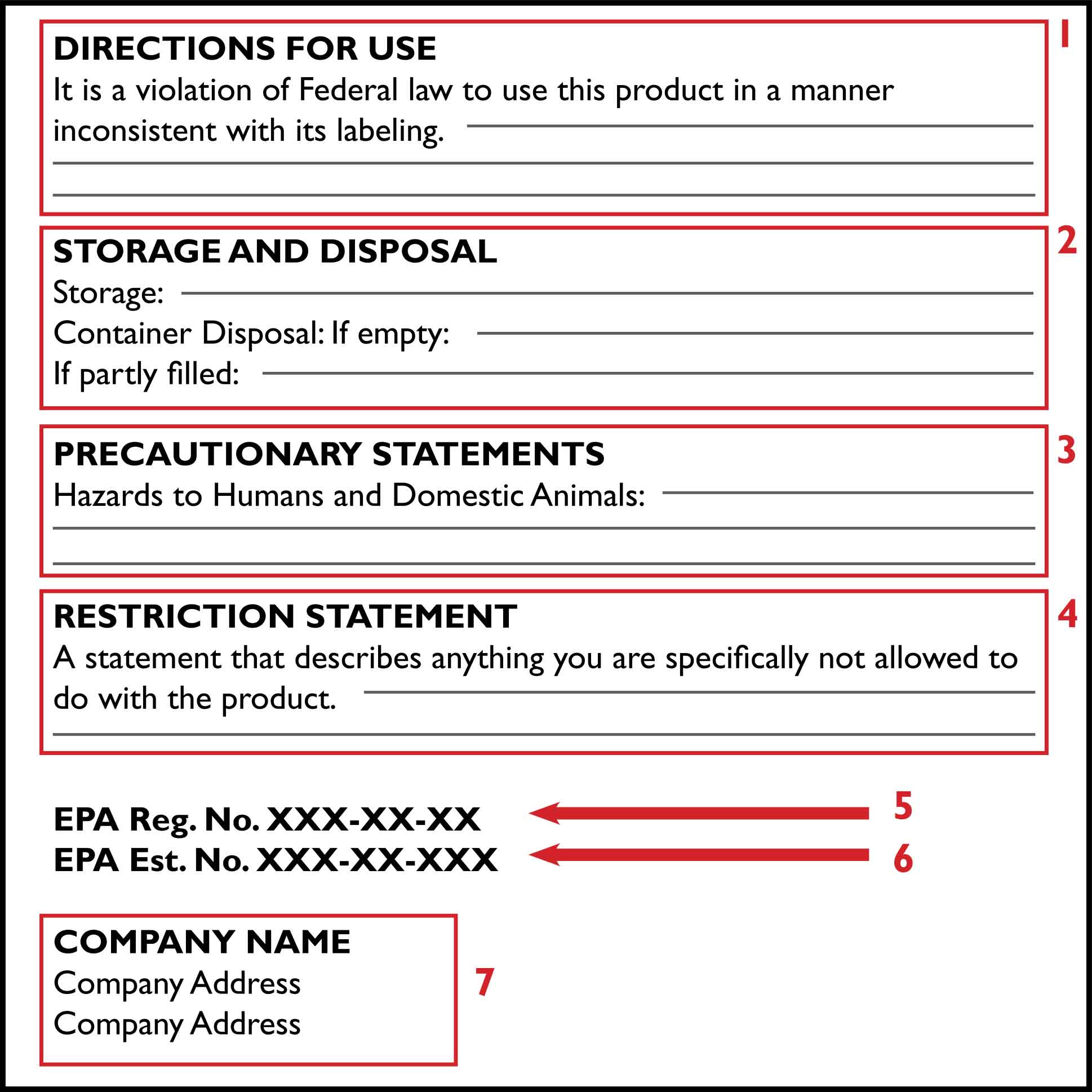
THE BACK LABEL
- The directions for use (1) of the product will generally be on the back label. These instructions tell you how, where, when and on what you are allowed to use the product. Using a product in a manner inconsistent with its labeling is a violation of the law.
- Instructions for storing and disposal (2) of the product will be found on the back label as well. Proper storage of the product is important not only for your safety but also to ensure the product maintains its shelf life. Proper disposal of a pesticide container, with or without pesticide still in it, is critical to protecting the environment, including our own air and water supplies.
- Precautionary statements (3) on the back label will tell you safety actions to take or protective equipment like gloves that you need.
- There may also be a restriction statement (4) on the back label. This statement tells you anything that you are specifically not allowed to do with product, such as applying during rain or to plants that have flowers on them.
ADDITIONAL LABELING
On either the front or back label you will find:
- The EPA registration number (5), written as either “EPA Registration No.” or “EPA Reg. No.,” is the number the EPA uses to track the pesticide. This number is unique to each product. We recommend using only products that list a registration number.
- The EPA establishment number (6), or “EPA Est.,” identifies the final location the product was produced or labeled.
- The company’s name and address (7) where you can reach someone.
Products that claim pesticidal activity but do not follow the labeling guidelines described here are called exempt products. The active ingredients in these products are exempt from review and registration under section 25(b) of the Federal Insecticide, Fungicide and Rodenticide Act (FIFRA). You should avoid these products, as there are no data that they work the way they claim. You may end up not only using more of these pesticides than you would have of a registered product but also still needing to turn to a different pesticide to control your problem. These products usually contain plant essential oils (e.g., lemongrass oil, rosemary oil, thyme oil) as active ingredients and often have unproven claims of “completely safe” or “100% effective” on their labels.
OMRI/Organic Labeling
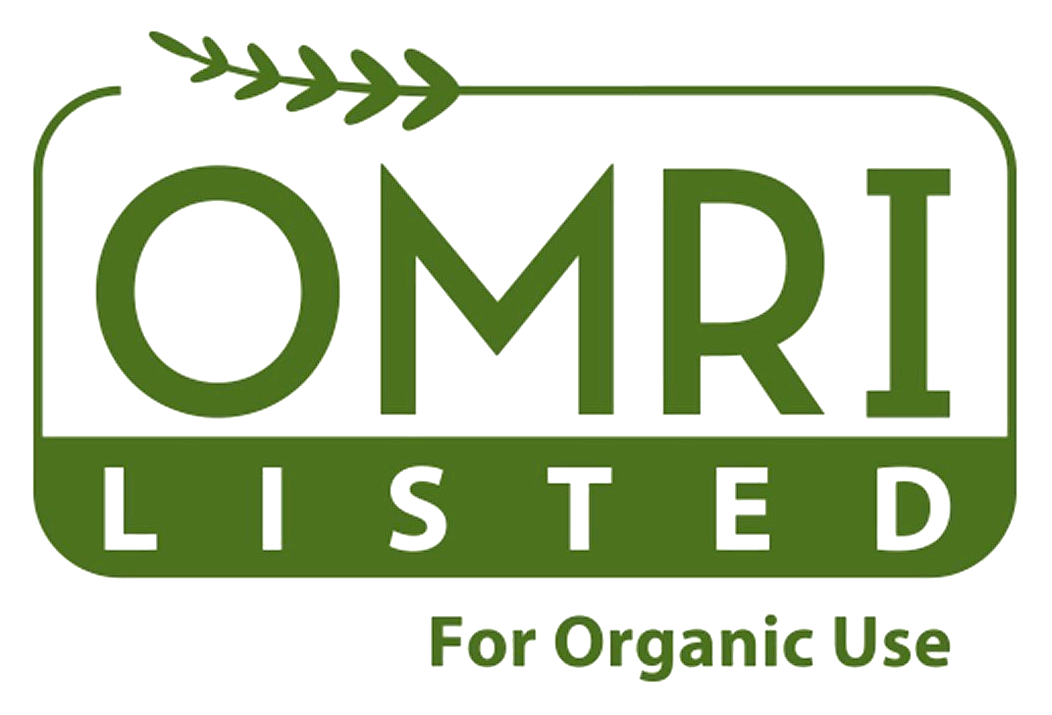 Look for organic-approved labeling on pesticides, such as that from the Organic Materials Review Institute (OMRI) or equivalent. OMRI develops and shares information and guidance about products such as fertilizers, pest controls and other inputs that are appropriate for use in organic operations. Products that meet OMRI’s standards are identified as OMRI Listed, and labels can display the OMRI seal shown here.
Look for organic-approved labeling on pesticides, such as that from the Organic Materials Review Institute (OMRI) or equivalent. OMRI develops and shares information and guidance about products such as fertilizers, pest controls and other inputs that are appropriate for use in organic operations. Products that meet OMRI’s standards are identified as OMRI Listed, and labels can display the OMRI seal shown here.- Note that organic labeling does not necessarily indicate lower toxicity or greater “safety” for this product as compared to others. It only means the product can be used in organic production.
- At the store, look for products with the OMRI seal that are targeted to your specific need. If you are shopping online, you can download the most current list of OMRI Listed products at the OMRI website.
“Green, Yellow and Red” Pesticides
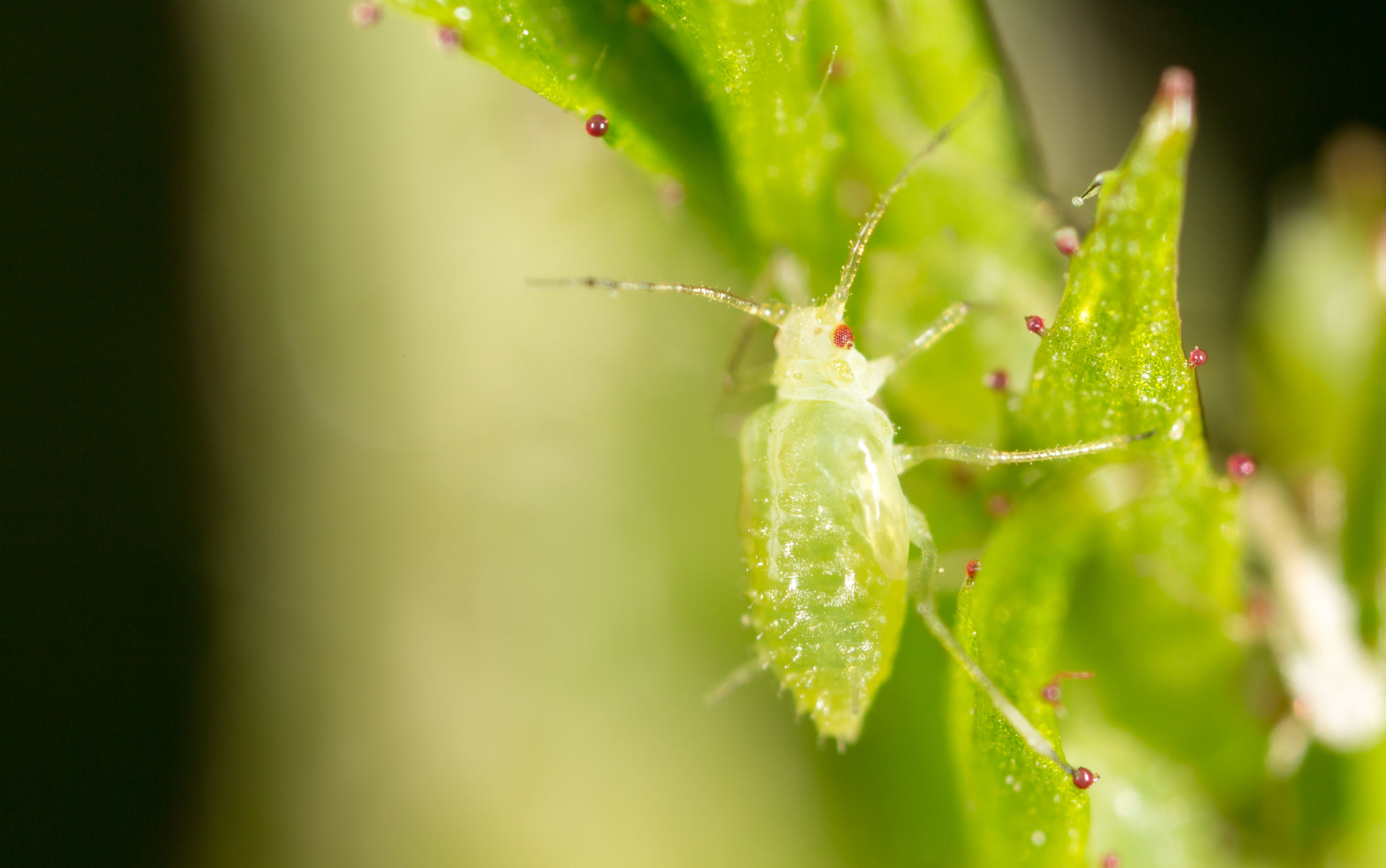
INSECTICIDES
- GREEN — Soft-bodied insects (e.g., aphids, whitefly, thrips) and some plant diseases (e.g., powdery mildew) can be controlled with products called horticultural oils and soaps. Horticultural oils may be based on a plant-derived oil, such as soybean oil, or on a petroleum-based oil.
- While these products are lower-risk, you must still always follow their labeled instructions.
- A note of caution: do not use a normal household dish soap to control pests. Soaps that contain detergent could strip the wax off of leaves and harm a plant.
- YELLOW — Some situations may arise that cannot be controlled using the products described above. Carefully consider all your management options and potential products before taking action.
- Biological insecticides are products based on chemicals derived from living organisms. These include products with active ingredients of Bt (from bacteria), spinosad (from bacteria), and neem oil (from a plant). Bt products are active on specific insects, so reading the label is very important.
- In extreme situations you may carefully consider a product with an active ingredient in the insecticide class called the pyrethroids. This includes the insecticides esfenvalerate, cypermethrin, permethrin, cyfluthrin, and deltamethrin (hint: look for active ingredient names ending in -thrin). Pyrethroids can affect many different insects, so take extra care when using these products. They can negatively impact pollinating insects.
- For stubborn or excessive problems with grubs (beetle larvae) in lawns, first pull up small samples of turf to check for actively feeding grubs, then lay the turf back into place. If you have grubs at the surface, you can consider a product containing the active ingredient chlorantraniliprole. This insecticide is reduced-risk relative to products containing a neonicotinoid insecticide. Only use a product for grubs if you can confirm you actually have a grub problem!
- If you have problems with snails or slugs, prioritize increasing air circulation and eliminating damp hiding spots. Beyond these preventative methods, some molluscicides may help if they are needed. The active ingredients sulfur and iron phosphate can help repel or kill these pests, but they often require repeated application. Be sure the plants around which you apply these products are not sensitive to changes in soil pH or metal concentrations.
- RED — There are some insecticides that should almost never be used by a homeowner around the house and landscape. Several examples are discussed below. The only time these may be acceptable is if they are recommended and applied by a licensed pest management professional.
- Insecticides containing active ingredients in the pesticide classes of organophosphates (e.g., dichlorvos, malathion, trichlorfon, chlorpyrifos), carbamates (e.g., carbaryl), and neonicotinoids (e.g., imidacloprid, clothianidin, acetamiprid, dinotefuran) should not be used by homeowners in their landscape. If absolutely necessary these products may be considered for application by a licensed pest management professional.
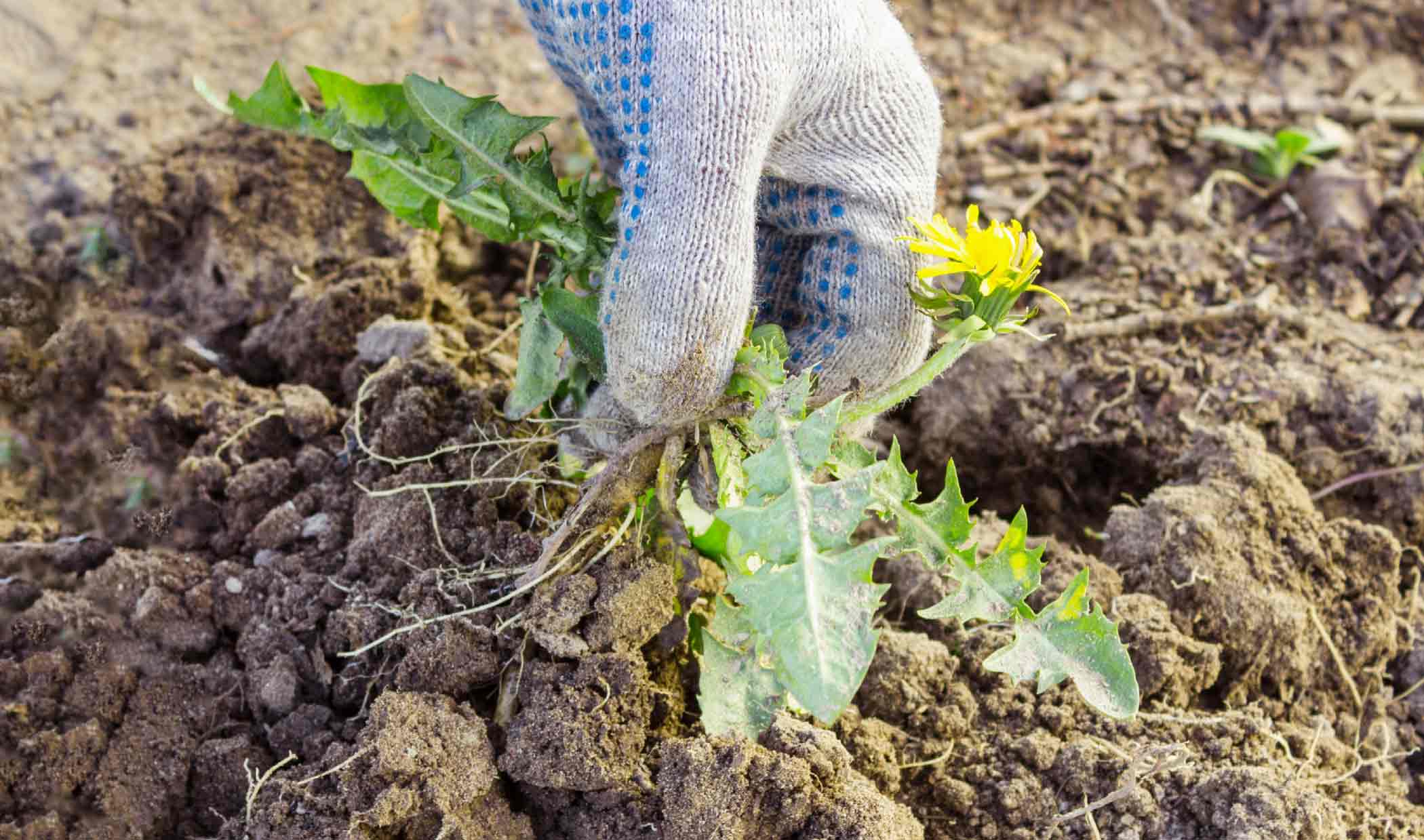
HERBICIDES
- GREEN — Prioritize excluding, suppressing, and manually removing weeds. Use the proper tools to ensure you remove the roots. See our section on eco-friendly landscape practices above for more information.
- Lower-risk herbicides that contain d-limonene (citrus oil) are available on the market. These products, known as burndown herbicides, kill foliage but not roots. Reapplication may be needed. Always follow the labeled instructions.
- Boiling water poured slowly over the roots of young weeds can help eliminate unwanted plants.
- YELLOW — Some situations may arise that cannot be controlled using the products described above. Carefully consider all your management options and potential products before taking action.
- Flame weeders may be used carefully to burn weeds. Never use fire to kill weeds around other dry or flammable material.
- Organic Material Review Institute (OMRI)-approved herbicides may be used if needed. Always read and follow the label.
- On small weeds in difficult areas like driveways and cracks, you may wish to use household vinegar. Use caution as vinegar can be corrosive at high concentrations. Vinegar is a burndown herbicide, so reapplication may be needed to achieve control.
- RED — Though you should try to avoid herbicides if at all possible, sometimes stubborn weeds with health implications like poison ivy may need to be targeted.
- If herbicides are needed, avoid the active ingredient glyphosate.
- Avoid herbicide and fertilizer combination products, also known as “weed and feed.”
Resources
- Proper identification of your pest is critical to effective management. Certain control methods will only work on certain pests! For identification help you can contact our Ask Dr. Phipps question-and-answer service.
- Find your local Penn State Extension office and contact them for help to identify your problem. They can also offer tips on management.
- Both computer-generated and expert-reviewed identifications of pest species may be provided by the iNaturalist phone app.
Select photos © Paul g. Wiegman, Aaron D'Addio


